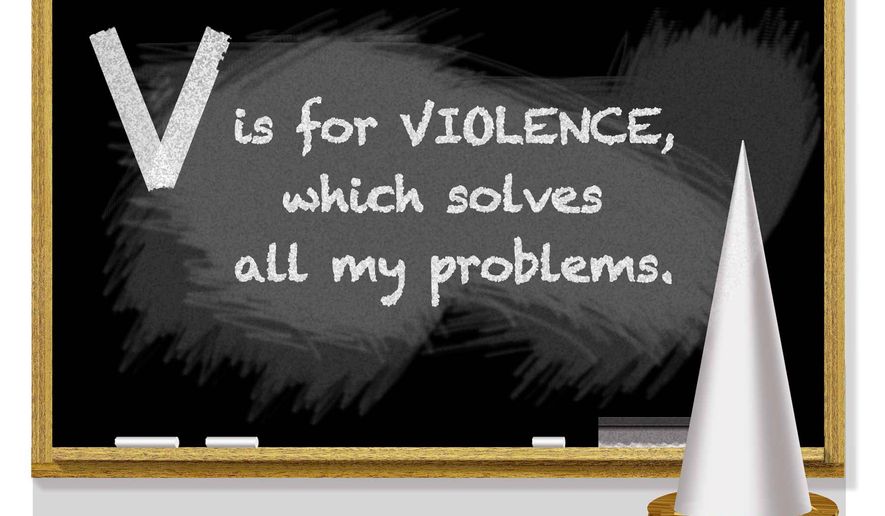OPINION:
In the span of four months, I witnessed constant student fights, girls skipping class to hang out in the restroom to make TikTok videos, boys watching pornography on school-issued Chromebooks, classroom doors being slammed out of anger, regular overt defiance toward staff and administration, and a student sexually assaulted and later attacked for “snitching.”
The day I had an 11-year-old screaming in my face, scissors thrown at my head, and no remedy for regaining order was the day I recognized I could not continue to teach in the present state.
The current K-12 school discipline model is failing students and teachers. It allows a physically and emotionally unsafe environment that has left students, teachers and administrators seriously injured. The lack of school discipline has also negatively affected the learning process and is leaving students with a heightened state of anxiety and uncertainty.
These issues are causing educators to leave the teaching profession. The solution is a willingness of teachers and administrators to be honest about the problem and hold students accountable for their actions.
With the meteoric rise in school violence becoming more public and a drastic fall in academic performance, we should demand that schools return to the implementation of time-tested and proven forms of behavioral and classroom management. The goal of a successful disciplinary structure should be to identify what is the least punitive consequence necessary to stop unwanted and disruptive behaviors in the classroom.
While roughly 5% to 10% of the student population typically accounts for the bulk of the discipline problems, schools should not allow such a small group’s inability to behave to become the problem of the remaining 90%.
Violent and unsafe students must be removed from the classroom. The current trend in discipline is to keep students in the learning environment even after they have repeatedly demonstrated that they are a threat to others.
For example, I recently taught a middle schooler who threw a classmate into a glass window, threatened to stab a girl in the eye, later stabbed a teacher with a blunt object, threatened other students with violence, and caused constant classroom disruptions. Finally, the student was suspended for threatening to kill a classmate.
Students who threaten the safety of those around them must be removed from the classroom until that student proves to no longer be a physical threat or harmful to the learning process.
Students deserve a safe and distraction-free learning environment, and they need one to be successful learners.
Misbehavior and student reactions during the learning phase have a profound effect on the retention of the information being taught. A Missouri study found that disruption during the recall of learned material resulted in a loss of 9% to 26% of the information. In addition, disturbances in the initial learning phase resulted in a learning loss of 46% to 59%.
That means that the more student behaviors are left to persist without correction or removal, the greater the learning loss for all students in the class. The resulting learning loss also increases student anxiety and mental health issues.
One of the ways schools can affect student mental health is the expectation of consistent discipline that stops disruptive and destructive behaviors. Anxiety and uncertainty have a negative impact on the learning process and on a student’s well-being. When students are in constant fight-or-flight response for fear of being bullied, harassed or assaulted, the focus on learning is pushed down the priority list.
Research has found that being in a constant state of stress increases the release of cortisol into the bloodstream. This results in chronic stress, which causes the brain to go blank, impairs cognitive performance and long-term memory, and leads to myriad health issues. This high-stress environment is not only affecting the learning process but is also having a lasting impact on the teachers.
If the K-12 education system wants to attract and keep highly effective and competent teachers, there needs to be a committed shift toward discipline policies and teacher training that works. Discipline issues are becoming the core reason teachers are leaving the profession.
That’s why I left teaching after 12 years. Spending the bulk of my attention and energy on behavior issues made it challenging to assist students in developing their reading and writing skills.
The current discipline model in K-12 schools is having a negative impact on our students’ academics and personal safety. It is time we demand a return to a behavioral system that holds students to account for their disruptive and unsafe actions. This will lead to improved outcomes for all students and the whole education environment.
• Rhyen Staley is a researcher for Parents Defending Education. He holds a master’s degree in elementary education and has over a decade of classroom experience in both public and private schools.




Please read our comment policy before commenting.